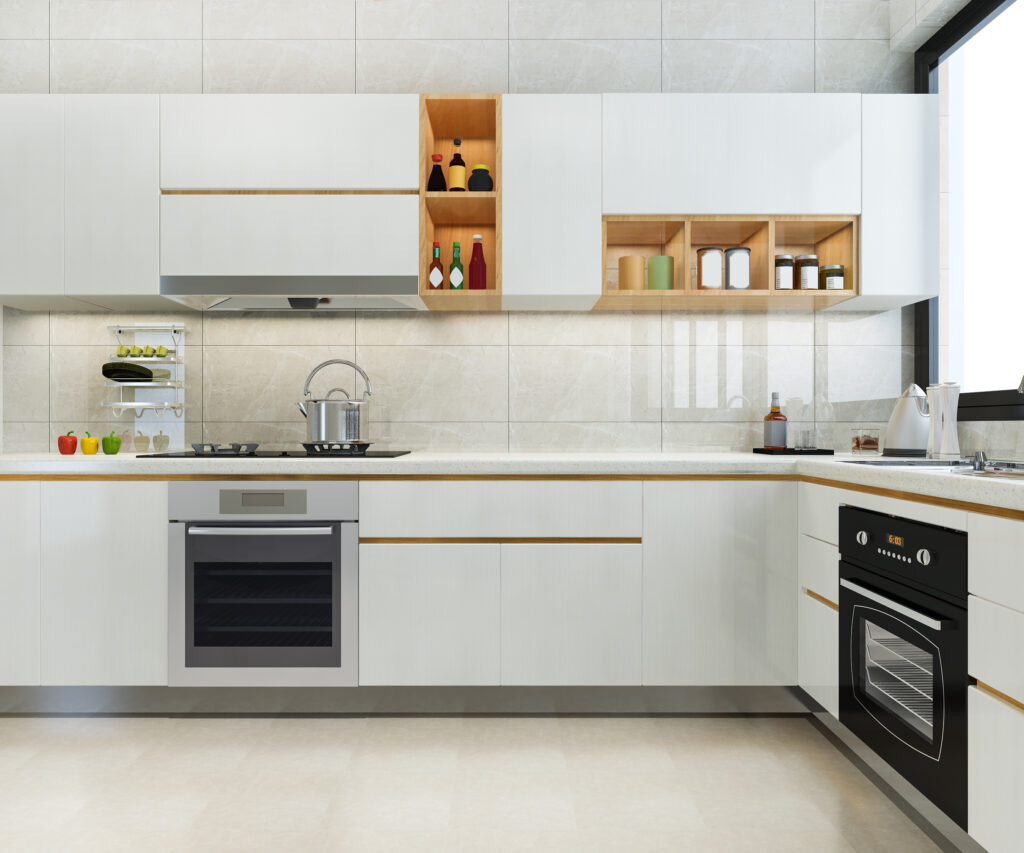In the world of home design, few decisions are as crucial as selecting the right flooring for your kitchen. As the heart of the home, your kitchen endures heavy foot traffic, frequent spills, and constant use. The perfect kitchen flooring must therefore strike a delicate balance between durability and aesthetics, withstanding the rigors of daily life while complementing your overall kitchen style. Let’s dive into the world of kitchen flooring options to help you make an informed decision for your next remodel or upgrade.

Understanding Your Kitchen’s Needs
The Importance of Durability
In a busy kitchen area, durability is paramount. Your chosen flooring should resist stains, scratches, and water damage while maintaining its appearance over time. High-traffic kitchen areas demand materials that can withstand constant use without showing excessive wear and tear.
Practicality Meets Style
While durability is crucial, your kitchen floor should also reflect your personal style and enhance your home’s overall aesthetic. The good news is that with modern flooring options, you don’t have to sacrifice beauty for practicality. Many durable materials come in a range of styles, colors, and patterns to suit any design preference.
Types of Flooring for Your Kitchen
Tile: A Timeless Choice
Ceramic and porcelain tiles have long been favored for kitchen flooring, and for good reason. These materials offer exceptional durability and water resistance, making them ideal for areas prone to spills and moisture.
Pros:
– Excellent durability and water resistance
– Wide range of styles, colors, and patterns
– Easy to clean and maintain
– Can mimic the look of more expensive materials like natural stone
Cons:
– Can be cold and hard underfoot
– Grout lines may require regular cleaning and sealing
Porcelain tiles, in particular, are known for their durability and resistance to stains and scratches. They’re an excellent choice for high-traffic kitchen areas and can withstand heavy foot traffic without showing signs of wear.
Vinyl: The Practical Powerhouse
Luxury vinyl flooring has come a long way in recent years, offering the look of wood or stone with added durability and water resistance.
Pros:
– Highly resistant to water, stains, and scratches
– Softer underfoot than tile, providing more comfort
– Wide variety of styles mimicking wood, stone, and tile
– Generally more affordable than natural materials
Cons:
– May not add as much value to your home as natural materials
– Can be prone to denting from heavy appliances
Vinyl flooring is an excellent option for busy kitchens, offering exceptional durability and easy maintenance. It’s also a great choice for those who want the look of wood or stone without the associated care requirements.
Hardwood and Engineered Wood: Natural Beauty
While solid hardwood can be prone to water damage in kitchen environments, engineered hardwood flooring provides a great alternative.
Pros:
– Adds warmth and natural beauty to your kitchen
– Can increase your home’s value
– Engineered options offer better resistance to moisture than solid hardwood
Cons:
– More susceptible to scratches and dents than tile or vinyl
– Requires more maintenance to keep its appearance
Engineered hardwood consists of a real wood veneer over a plywood base, making it more stable and resistant to moisture than solid hardwood. It’s a good compromise for those who love the look of wood but need added durability for their kitchen.
Laminate: Budget-Friendly Option
Laminate flooring can mimic the look of more expensive materials like wood and stone while offering good durability at a lower price point.
Pros:
– More affordable than natural materials
– Resistant to scratches and stains
– Easy to clean and maintain
– Wide variety of styles available
Cons:
– Less water-resistant than other options (though water-resistant varieties are available)
– May not add as much value to your home as natural materials
Laminate can be a great choice for those on a budget who still want a durable, attractive kitchen floor. Modern laminate options can convincingly mimic the look of wood, stone, or tile.
Natural Stone: Luxurious and Unique
For those seeking a high-end look, natural stone like granite, marble, or slate can add a touch of luxury to your kitchen.
Pros:
– Unique, natural beauty
– Extremely durable when properly sealed
– Can increase your home’s value
Cons:
– Expensive compared to other options
– Requires regular sealing to prevent stains
– Can be cold and hard underfoot
Natural stone offers unparalleled beauty and uniqueness, with no two floors exactly alike. However, it requires more maintenance than some other options and can be a significant investment.
Choosing the Right Kitchen Flooring
Consider Your Kitchen Style
Your flooring should complement your overall kitchen design. Here are some style considerations:
– For modern kitchens: Large format tiles, sleek vinyl, or polished concrete
– For traditional kitchens: Hardwood, natural stone, or classic tile patterns
– For rustic kitchens: Distressed wood-look vinyl or laminate, textured stone tiles
Evaluate Practicality
Consider these practical factors when choosing your kitchen flooring:
– Ease of cleaning: Smooth surfaces like vinyl and tile are generally easiest to clean
– Water resistance: Critical for kitchens; vinyl and porcelain tile excel here
– Comfort underfoot: If you spend a lot of time cooking, softer options like vinyl or engineered wood might be preferable
– Maintenance requirements: Some materials, like natural stone or hardwood, require more regular maintenance
Think Long-Term
Invest in quality flooring that will withstand the test of time. While it might be tempting to choose the cheapest option, remember that your kitchen floor endures heavy use. A more durable, higher-quality flooring can save you money in the long run by lasting longer and maintaining its appearance.
Making Your Final Decision
The perfect kitchen flooring balances durability, aesthetics, and practicality. Here are some final tips to help you decide:
- Get samples: Bring home samples of your top choices to see how they look in your kitchen’s lighting and with your cabinetry.
- Consider your lifestyle: If you have pets or young children, you might prioritize scratch resistance and ease of cleaning.
- Think about resale value: If you plan to sell your home in the near future, neutral, high-quality flooring options can be attractive to potential buyers.
- Set a realistic budget: Remember to factor in not just the cost of materials, but also installation and any necessary subfloor preparation.
- Don’t forget underlayment: For options like vinyl or laminate, a good underlayment can improve comfort and sound absorption.
Remember, your kitchen is the heart of your home. The right flooring can add both beauty and functionality to this crucial space, making your kitchen remodel a success. Whether you choose the timeless luxury of natural stone, the warmth of engineered hardwood, or the exceptional durability of porcelain tiles, ensure your choice suits your lifestyle and design preferences.
By carefully considering your options and balancing practicality with style, you can select kitchen flooring that will serve you well for years to come. Your perfect kitchen floor is out there – one that withstands the rigors of daily life while beautifully complementing your home’s aesthetic. Happy flooring hunting!
Ready to transform your kitchen with the perfect flooring? Contact us today for a free consultation and expert installation!
